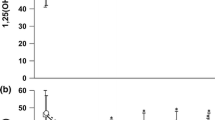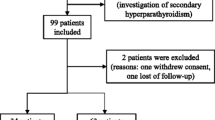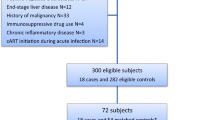Abstract
There are no data about the optimal supplementation therapy in HIV-infected patients with vitamin D (25OHD) deficiency. The aim of this study was to assess the effect of an oral monthly dose of 16,000 IU calcidiol. We performed a longitudinal cohort study of 365 HIV-infected patients (24 % females) was with sequential determinations of 25OHD, serum parathyroid hormone (PTH), calcium, and alkaline phosphatase. The efficacy and safety of supplementation in 123 patients were compared against dietary and sun exposure advice. Overall, mean baseline 25OHD levels were 19.1 ng/ml (IQR 12–23.6), 63 % of patients had 25OHD deficiency and 27 % secondary hyperparathyroidism. After a median time of 9.3 months (95.61 patients-year on-treatment), 25OHD levels increased in comparison with non-supplemented patients (+16.4 vs. +3.2 ng/ml; p < 0.01), decreasing the rate of 25OHD deficiency (from 84 to 24 %), and decreasing serum PTH (−4.9 pg/ml) and the rate of secondary hyperparathyroidism (from 43 to 31 %; p < 0.001). This improvement was observed irrespective of HIV/HCV coinfection or the use of efavirenz. In a regression analysis, adjusting by seasonality, a lower baseline 25OHD was associated with persistence of deficiency (relative risk, RR 1.07; 95 % CI 1.03–1.1; p < 0.001), whereas calcidiol supplementation was the only factor associated with significant improvement (RR 0.38; 95 % CI 0.12–0.46; p < 0.001). This monthly dose showed no clinical toxicity, and no patient had 25OHD levels above 100 ng/ml, nor hypercalcemia. The use of monthly calcidiol is safe, easy to take, and largely effective to improve vitamin D deficiency and secondary hyperparathyroidism in HIV-infected patients.



Similar content being viewed by others
References
A.L. Willig, E.T. Overton, Metabolic consequences of HIV: pathogenic insights. Curr. HIV/AIDS Rep. 11(1), 35–44 (2014). doi:10.1007/s11904-013-0191-7
C.N. Dao, P. Patel, E.T. Overton, F. Rhame, S.L. Pals, C. Johnson, T. Bush, J.T. Brooks, Low vitamin D among HIV-infected adults: prevalence of and risk factors for low vitamin D Levels in a cohort of HIV-infected adults and comparison to prevalence among adults in the US general population. Clin. Infect. Dis. 52(3), 396–405 (2011). doi:10.1093/cid/ciq158
O.M. Adeyemi, D. Agniel, A.L. French, P.C. Tien, K. Weber, M.J. Glesby, M.C. Villacres, A. Sharma, D. Merenstein, E.T. Golub, W. Meyer, M. Cohen, Vitamin D deficiency in HIV-infected and HIV-uninfected women in the United States. J. Acquir. Immune Defic. Syndr. 57(3), 197–204 (2011). doi:10.1097/QAI.0b013e31821ae418
M. Cervero, J.L. Agud, C. Garcia-Lacalle, V. Alcazar, R. Torres, J.J. Jusdado, S. Moreno Guillen, Prevalence of vitamin D deficiency and its related risk factor in a Spanish cohort of adult HIV-infected patients: effects of antiretroviral therapy. AIDS Res. Hum. Retrovir 28(9), 963–971 (2012). doi:10.1089/AID.2011.0244
B. Terrier, F. Carrat, G. Geri, S. Pol, L. Piroth, P. Halfon, T. Poynard, J.C. Souberbielle, P. Cacoub, Low 25-OH vitamin D serum levels correlate with severe fibrosis in HIV-HCV co-infected patients with chronic hepatitis. J. Hepatol. 55(4), 756–761 (2011). doi:10.1016/j.jhep.2011.01.041
T.T. Brown, G.A. McComsey, Association between initiation of antiretroviral therapy with efavirenz and decreases in 25-hydroxyvitamin D. Antivir Ther 15(3), 425–429 (2010). doi:10.3851/IMP1502
Van Den Bout-Van, C.J. Den Beukel, L. Fievez, M. Michels, F.C. Sweep, A.R. Hermus, M.E. Bosch, D.M. Burger, B. Bravenboer, P.P. Koopmans, A.J. Van Der Ven, Vitamin D deficiency among HIV type 1-infected individuals in the Netherlands: effects of antiretroviral therapy. AIDS Res Hum Retrovir 24(11), 1375–1382 (2008). doi:10.1089/aid.2008.0058
H.A. Bischoff-Ferrari, A. Shao, B. Dawson-Hughes, J. Hathcock, E. Giovannucci, W.C. Willett, Benefit-risk assessment of vitamin D supplementation. Osteoporos. Int. 21(7), 1121–1132 (2010). doi:10.1007/s00198-009-1119-3
K.C. Chiu, A. Chu, V.L. Go, M.F. Saad, Hypovitaminosis D is associated with insulin resistance and beta cell dysfunction. Am. J. Clin. Nutr. 79(5), 820–825 (2004)
D.J. Llewellyn, K.M. Langa, I.A. Lang, Serum 25-hydroxyvitamin D concentration and cognitive impairment. J. Geriatr. Psychiatry Neurol. 22(3), 188–195 (2009). doi:10.1177/0891988708327888
E.T. Overton, M.T. Yin, The rapidly evolving research on vitamin D among HIV-infected populations. Curr Infect Dis Rep 13(1), 83–93 (2011). doi:10.1007/s11908-010-0144-x
S. Mehta, E. Giovannucci, F.M. Mugusi, D. Spiegelman, S. Aboud, E. Hertzmark, G.I. Msamanga, D. Hunter, W.W. Fawzi, Vitamin D status of HIV-infected women and its association with HIV disease progression, anemia, and mortality. PLoS ONE 5(1), e8770 (2010). doi:10.1371/journal.pone.0008770
J.P. Viard, J.C. Souberbielle, O. Kirk, J. Reekie, B. Knysz, M. Losso, J. Gatell, C. Pedersen, J.R. Bogner, J.D. Lundgren, A. Mocroft, Vitamin D and clinical disease progression in HIV infection: results from the EuroSIDA study. AIDS 25(10), 1305–1315 (2011). doi:10.1097/QAD.0b013e328347f6f7
C.K. Kwan, B. Eckhardt, J. Baghdadi, J.A. Aberg, Hyperparathyroidism and complications associated with vitamin D deficiency in HIV-infected adults in New York City, New York. AIDS Res Hum Retrovir 28(9), 1025–1032 (2012). doi:10.1089/AID.2011.0325
J.L. Casado, S. Banon, R. Andres, M.J. Perez-Elias, A. Moreno, S. Moreno, Prevalence of causes of secondary osteoporosis and contribution to lower bone mineral density in HIV-infected patients. Osteoporos Int 25(3), 1071–1079 (2014). doi:10.1007/s00198-013-2506-3
Martinez, E., Jodar Gimeno, E., Reyes Garcia, R., Carpintero, P., Casado, J.L., Del Pino Montes, J., Domingo Pedrol, P., Estrada, V., Maalouf, J., Negredo, E., Ocampo, A., Munoz-Torres, M.: [Consensus statement: Recommendations for the management of metabolic bone disease in human immunodeficiency virus patients.]. Enfermedades infecciosas y microbiologia clinica (2013). doi:10.1016/j.eimc.2013.07.008
C. del Rio, Updated antiretroviral treatment guidelines from DHHS and EACS. AIDS Clin. Care 20(1), 7 (2008)
G. Dragovic, D. Jevtovic, Report on the 13th European AIDS conference/EACS. Vojnosanitetski pregled. Milit Med Pharm Rev 69(1), 98–99 (2012)
Rigueira Garcia, A.I.: [Recommendations on vitamin D and calcium supplements for adults in Spain]. Rev Esp Salud Publica 86(5), 461–482 (2012). doi:10.4321/S1135-57272012000500002
Torregrosa, J.V., Bover, J., Cannata Andia, J.: Spanish society of nephrology recommendations for controlling mineral and bone disorder in chronic kidney disease patients (S.E.N.-M.B.D.). Introduction. Nefrologia 31(Suppl 1), 1–2 (2011). doi:10.3265/Nefrologia.pre2011.Jan.10815
M.F. Holick, N.C. Binkley, H.A. Bischoff-Ferrari, C.M. Gordon, D.A. Hanley, R.P. Heaney, M.H. Murad, C.M. Weaver, Evaluation, treatment, and prevention of vitamin D deficiency: an Endocrine Society clinical practice guideline. J Clin Endocrinol Metab 96(7), 1911–1930 (2011). doi:10.1210/jc.2011-0385
C.J. Rosen, J.C. Gallagher, The 2011 IOM report on vitamin D and calcium requirements for north america: clinical implications for providers treating patients with low bone mineral density. J Clin Densitom 14(2), 79–84 (2011). doi:10.1016/j.jocd.2011.03.004
S.J. Silverberg, E.M. Lewiecki, L. Mosekilde, M. Peacock, M.R. Rubin, Presentation of asymptomatic primary hyperparathyroidism: proceedings of the third international workshop. J Clin Endocrinol Metab 94(2), 351–365 (2009). doi:10.1210/jc.2008-1760
A.K. Kasahara, R.J. Singh, A. Noymer, Vitamin D (25OHD) serum seasonality in the United States. PLoS ONE 8(6), e65785 (2013). doi:10.1371/journal.pone.0065785
M.F. Holick, E.S. Siris, N. Binkley, M.K. Beard, A. Khan, J.T. Katzer, R.A. Petruschke, E. Chen, A.E. de Papp, Prevalence of Vitamin D inadequacy among postmenopausal North American women receiving osteoporosis therapy. J Clin Endocrinol Metab 90(6), 3215–3224 (2005). doi:10.1210/jc.2004-2364
P.L. Havens, C.B. Stephensen, R. Hazra, P.M. Flynn, C.M. Wilson, B. Rutledge, J. Bethel, C.G. Pan, L.R. Woodhouse, M.D. Van Loan, N. Liu, J. Lujan-Zilbermann, A. Baker, B.G. Kapogiannis, K. Mulligan, Adolescent Medicine trials network for, H.I.V.A.I.s.t.: Vitamin D3 decreases parathyroid hormone in HIV-infected youth being treated with tenofovir: a randomized, placebo-controlled trial. Clin Infect Dis 54(7), 1013–1025 (2012). doi:10.1093/cid/cir968
V. Giacomet, A. Vigano, V. Manfredini, C. Cerini, G. Bedogni, S. Mora, M. Borelli, D. Trabattoni, G.V. Zuccotti, Cholecalciferol supplementation in HIV-infected youth with vitamin D insufficiency: effects on vitamin D status and T-cell phenotype: a randomized controlled trial. HIV Clin Trials 14(2), 51–60 (2013). doi:10.1310/hct1402-51
C.T. Longenecker, C.O. Hileman, T.L. Carman, A.C. Ross, S. Seydafkan, T.T. Brown, D.E. Labbato, N. Storer, V. Tangpricha, G.A. McComsey, Vitamin D supplementation and endothelial function in vitamin D deficient HIV-infected patients: a randomized placebo-controlled trial. Antivir Ther 17(4), 613–621 (2012). doi:10.3851/IMP1983
R.J. Piso, M. Rothen, J.P. Rothen, M. Stahl, C. Fux, Per oral substitution with 300000 IU vitamin D (Cholecalciferol) reduces bone turnover markers in HIV-infected patients. BMC Infect. Dis. 13, 577 (2013). doi:10.1186/1471-2334-13-577
L. Tripkovic, H. Lambert, K. Hart, C.P. Smith, G. Bucca, S. Penson, G. Chope, E. Hypponen, J. Berry, R. Vieth, S. Lanham-New, Comparison of vitamin D2 and vitamin D3 supplementation in raising serum 25-hydroxyvitamin D status: a systematic review and meta-analysis. Am. J. Clin. Nutr. 95(6), 1357–1364 (2012). doi:10.3945/ajcn.111.031070
M. Etminani-Esfahani, H. Khalili, S. Jafari, A. Abdollahi, S. Dashti-Khavidaki, Effects of vitamin D supplementation on the bone specific biomarkers in HIV infected individuals under treatment with efavirenz. BMC Res Notes 5, 204 (2012). doi:10.1186/1756-0500-5-204
K.D. Cashman, K.M. Seamans, A.J. Lucey, E. Stocklin, P. Weber, M. Kiely, T.R. Hill, Relative effectiveness of oral 25-hydroxyvitamin D3 and vitamin D3 in raising wintertime serum 25-hydroxyvitamin D in older adults. Am. J. Clin. Nutr. 95(6), 1350–1356 (2012). doi:10.3945/ajcn.111.031427
H.A. Bischoff-Ferrari, B. Dawson-Hughes, E. Stocklin, E. Sidelnikov, W.C. Willett, J.O. Edel, H.B. Stahelin, S. Wolfram, A. Jetter, J. Schwager, J. Henschkowski, A. von Eckardstein, A. Egli, Oral supplementation with 25(OH)D3 versus vitamin D3: effects on 25(OH)D levels, lower extremity function, blood pressure, and markers of innate immunity. J Bone Miner Res 27(1), 160–169 (2012). doi:10.1002/jbmr.551
N.E. Cusano, S.J. Silverberg, J.P. Bilezikian, Normocalcemic primary hyperparathyroidism. J Clin Densitom 16(1), 33–39 (2013). doi:10.1016/j.jocd.2012.12.001
S.J. Silverberg, B.L. Clarke, M. Peacock, F. Bandeira, S. Boutroy, N.E. Cusano, D. Dempster, E.M. Lewiecki, J.M. Liu, S. Minisola, L. Rejnmark, B.C. Silva, M.D. Walker, J.P. Bilezikian, Current issues in the presentation of asymptomatic primary hyperparathyroidism: proceedings of the fourth international workshop. J Clin Endocrinol Metab 99(10), 3580–3594 (2014). doi:10.1210/jc.2014-1415
M.F. Holick, Vitamin D deficiency. N. Engl. J. Med. 357(3), 266–281 (2007). doi:10.1056/NEJMra070553
G. Jones, Pharmacokinetics of vitamin D toxicity. Am J Clin Nutr 88(2), 582S–586S (2008)
A. Conesa-Botella, E. Florence, L. Lynen, R. Colebunders, J. Menten, R. Moreno-Reyes, Decrease of vitamin D concentration in patients with HIV infection on a non nucleoside reverse transcriptase inhibitor-containing regimen. AIDS Res Ther 7, 40 (2010). doi:10.1186/1742-6405-7-40
J. Fox, B. Peters, M. Prakash, J. Arribas, A. Hill, C. Moecklinghoff, Improvement in vitamin D deficiency following antiretroviral regime change: results from the MONET trial. AIDS Res. Hum. Retrovir 27(1), 29–34 (2011). doi:10.1089/aid.2010.0081
T. Welz, K. Childs, F. Ibrahim, M. Poulton, C.B. Taylor, C.F. Moniz, F.A. Post, Efavirenz is associated with severe vitamin D deficiency and increased alkaline phosphatase. AIDS 24(12), 1923–1928 (2010). doi:10.1097/QAD.0b013e32833c3281
P.L. Havens, K. Mulligan, R. Hazra, P. Flynn, B. Rutledge, M.D. Van Loan, J. Lujan-Zilbermann, B.G. Kapogiannis, C.M. Wilson, C.B. Stephensen, Adolescent Medicine Trials Network for, H.I.V.A.I.S.T.: Serum 25-hydroxyvitamin D response to vitamin D3 supplementation 50,000 IU monthly in youth with HIV-1 infection. J Clin Endocrinol Metab 97(11), 4004–4013 (2012). doi:10.1210/jc.2012-2600
K. Rajakumar, J.D. Fernstrom, M.F. Holick, J.E. Janosky, S.L. Greenspan, Vitamin D status and response to Vitamin D(3) in obese vs. non-obese African American children. Obesity 16(1), 90–95 (2008). doi:10.1038/oby.2007.23
Acknowledgments
We would like to thank Ana Abad for their important contribution in database management.
Conflict of interest
The authors state that they have no conflict of interest to declare.
Funding
This research did not receive any specific grant from any funding agency in the public, commercial or not-for-profit sector.
Author information
Authors and Affiliations
Corresponding author
Rights and permissions
About this article
Cite this article
Bañón, S., Rosillo, M., Gómez, A. et al. Effect of a monthly dose of calcidiol in improving vitamin D deficiency and secondary hyperparathyroidism in HIV-infected patients. Endocrine 49, 528–537 (2015). https://doi.org/10.1007/s12020-014-0489-2
Received:
Accepted:
Published:
Issue Date:
DOI: https://doi.org/10.1007/s12020-014-0489-2




